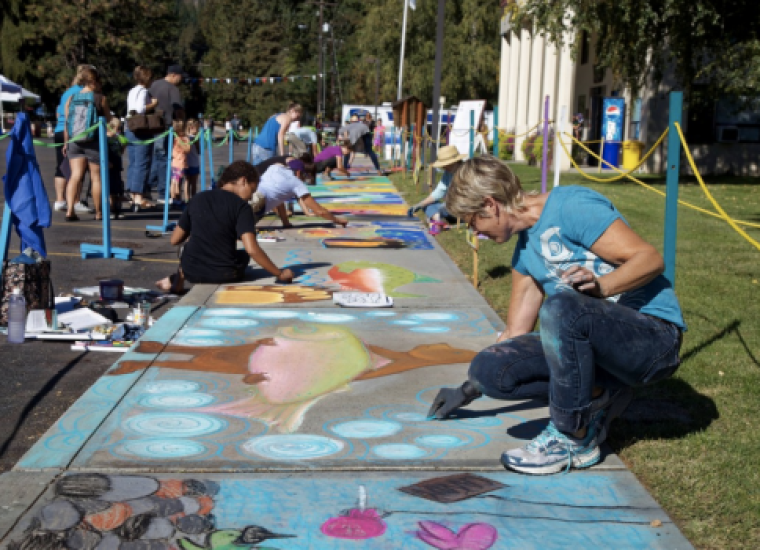The growing interest in co-creative practice has been accelerated by the challenges of the pandemic and the reverberations of movements like Black Lives Matter and Me Too, which have highlighted systemic inequality. Cultural organisations are asking themselves what role can they play in forging a more equitable culture, what kind of asset can they be to their community in future - and how can they do it?
We have long had evidence – from Not For the Likes of You in 2007 to the recent successes of Creative People and Places and many other projects that adopt a co-creative approach – which demonstrates unequivocally that co-creation lies at the heart of any determined effort to become inclusive and to draw in the wider community.
"‘Creating the right conditions’ is essential but quite difficult to achieve in practice. It takes patience, warmth and a willingness to be vulnerable as a practitioner. Some of the most useful and nourishing conversations happen during that prelude to a workshop or meeting, getting a brew together, finding out about a person’s morning. These moments shouldn’t be underplayed. Nurturing these grass roots connections builds trust and when people see you showing up, to their space, they begin to approach you."
Co-creation practitioners at risk
Frustratingly however, this research also suggests that those professionals who have developed skills and know-how are some of those most at risk of losing their contracts or jobs as organisations are forced to keep an eye on the bottom line. And yet, there is also evidence to suggest that organisations who learn how to co-design their offerings with a more user-centred approach are more resilient and able to weather financial crises over the long-term.
In a sense, then, all organisations need to think about how they could move toward a greater degree of co-design, even though this may look very different in different places. I spoke to some colleagues and partners, co-creation specialists and enthusiasts and asked them: can we all be co-designers now?
Encouraging participation is not about ‘doing people a favour’
Ashleigh Hibbins, my colleague here at The Audience Agency says: “We can certainly all move in that direction. The first thing is to be clear about what 'co-creation' and 'co-design' actually mean in practice. I’ve been facilitating co-creative activity for over 10 years, and I still struggle to understand what is unique about co-creation, compared with more traditional participation activities.
“If I’m honest, some co-creation projects use the jargon but don’t necessarily serve the audiences we seek to involve. For me that means creating the conditions in which your community helps you to make important, material decisions about the future – whether that’s about the building you run, the exhibition you’re putting on or the experience you’re organising. It is not about ‘doing people a favour’ but it IS about power.
“More importantly, you can’t assume that everyone wants to collaborate in your project. The idea that people are just sitting around waiting to be ‘empowered’ by arts organisations who have ignored their needs and interests in the past is naïve at best. After all, it is usually arts organisations who are asking communities to participate and create with us, not the other way around.
“This isn’t to suggest that participants don’t gain huge benefits from working with cultural organisations and talented creative practitioners. They most demonstrably do, more that I don’t think we should expect people to be grateful when an organisation ‘allows’ them the opportunity to co-create. The best projects I’ve worked with start with a question: 'What can we do together?’ Instead of an invitation to participate in something pre-made.”
Creating the right conditions
Carly Henderson, our head of Co-Creation was until recently Head of Learning and Engagement at Oldham Coliseum, running a raft of co-creative programmes. She says: “I think ‘creating the right conditions’ is essential but quite difficult to achieve in practice. It takes patience, warmth and a willingness to be vulnerable as a practitioner. Some of the most useful and nourishing conversations happen during that prelude to a workshop or meeting, getting a brew together, finding out about a person’s morning. These moments shouldn’t be underplayed. Nurturing these grass roots connections builds trust and when people see you showing up, to their space, they begin to approach you.
“I agree with Ashleigh’s point about starting with a question – it opens a space for a project or relationship to develop and allows people to help set the agenda from the outset. Developing a question or provocation with a group is another interesting way of starting a process, distilling everyone’s ideas and contributions into a concept for creative and critical exploration.
“The bad news is there’s no real short-cut, but the good news is that the effects are long-lasting, and the process is cumulative as others see the possibilities.”
The long game
Colleagues are unanimous that co-creation doesn’t begin with a specific project or pot of funding. It’s a way of thinking and working that requires reflective and reflexive thinking, and if you embrace it, you are implicitly challenging deeply ingrained beliefs in our society about who the arts are for and why they exist.
As one of our collaborators said: “The archetypes of the ‘expert curator’ or ‘artistic genius’ who are the ultimate authorities on good taste, legitimacy, and excellence, and who provide a one-way transfer of expertise to a grateful, ignorant public are still replicated and embedded in our society. Working in a co-creative way is a very concrete and practical way of challenging these unhelpful constructs which serve only to exclude.”
Many suggest it is not enough to simply provide creative opportunities for communities, we need to learn how to value their ideas and expertise in what we do and start to build a shared vision.
Six steps to building a foundation for meaningful participation
So how can we gain trust and buy-in from communities we want to work with, whilst at the same time promoting the very real benefits of co-creation and participation in the arts? Here are some basic principles:
- Prioritise relationship-building in the community for its own sake, not just as a means to achieve a specific project or pot of funding. Many organisations report having found a new role during the pandemic – as a food bank or SureStart centre – which has helped to put them on the map in their community.
- Compensate participants for their time and expertise. This reduces financial barriers to taking part, and ensures the relationship is truly an equal exchange instead of exploitative.
- Invest the time, effort and patience. It takes time to build trusting relationships. This can be a difficult ‘sell’ to stakeholders looking for a quick fix but it is critical for building meaningful collaboration in the long term.
- Think about legacy right from the beginning. Think long-term relationship not one-night-stand. Although often tricky in our current funding landscape, it’s important to plan right from the start of a project for how connections with participants will be maintained and strengthened after the co-creation has finished.
- Be open to embracing unexpected ideas, directions, and outcomes. A truly collaborative project doesn’t define specific outputs and structures in advance but allows participants to think and act outside the box, to challenge the partner organisation, and ultimately create something that may be entirely unexpected. True co-creation is not giving participants a specific brief to adhere to.
- Value and celebrate co-created work. Show respect and commitment by being as loud-and-proud of your co-created work as a main collection or a blockbuster performance. Other audiences often find the co-creation process interesting in itself.
This article was originally published in Arts Professional as part of a series sharing insights into the audiences for arts and culture.




